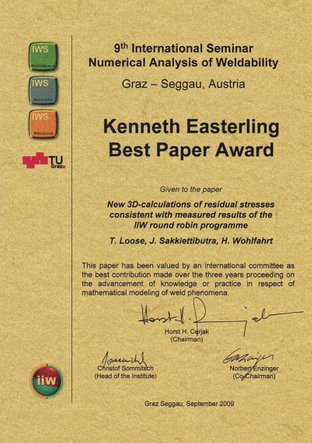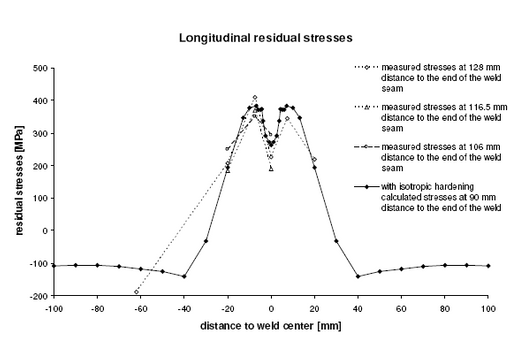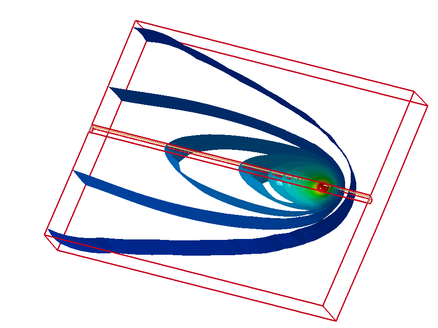
New 3D-Calculations of residual stresses consistent with measured results of the IIW Round Robin Programme
The project participates on the IIW Round Robin test for valitation of calcualted resisual stresses induced by welding.
The publication of this project was honored 2009 on the 9th International Seminar Numerical Analysis of Weldabilaty in Seggau / Österreich with the Keneth Easterling Best Paper Award.
Partner:
Dr.-Ing. Tobias Loose
Dr.-Ing. Jens Sakkietibutra
Prof. Dr.-Ing. Helmut Wohlfahrt
The joint working group Residual Stresses of IIW commissions X, XIII and XV has carried out a Round Robin Programme on calculation and measurement of residual stresses in an austenitic steel plate (steel type 316L, 270 mm x 200 mm x 30 mm, TIG welded, two deposits). Measurements by means of X-ray diffraction, neutron diffraction, with the hole drilling method and with electron Speckle-interferometry have revealed pronounced maxima of the longitudinal residual stresses up to more than 500 MPa in the heat affected zone (HAZ). But it is completely unsatisfying that calculations of all contributors using kinematic hardening as material law have not been able to detect such maxima in the HAZ. Only a rather broad horizontal plateau of tensile residual stresses with magnitudes in the range of the yield strength at room temperature (yield stress = 275 MPa, residual stress = 240 MPa to 290 MPa) was shown from the calculations.
Now new 3D-calculations using isotropic hardening in connection with the SYSWELD programme indicate distributions of the longitudinal - and also the transverse - residual stresses which are convincingly consistent with the results of the measurements. The agreement is especially good if one compares the calculations with measurements integrating the residual stresses over the same depth as the depth dimension of the calculation elements is.
The paper about these new comprehensive calculation results presents the total distribution of longitudinal and of transverse residual stresses not only in graphs of the top side after cooling, but also at different time steps during the process. With additional calculations of the von Mieses stresses, strain hardening, deformations, elastic and plastic strains the origin of the residual stress maxima and minima in the HAZ and in the weld seam of the plate can be explained. It has to be discussed whether it is good enough to use pure isotropic hardening in the constitutive law to get correct results or whether a mixed hardening concept should be used. Additional calculations in the paper demonstrate that the pronounced maxima of longitudinal residual stresses can actually not be found with a kinematic hardening concept. Thus the paper offers arguments that calculations with kinematic hardening may overestimate the influence of the Bauschinger effect especially for materials with a rather high strain hardening exponent like austenitic steels. Such an overestimation could consequently result in an underestimation of the yield strength after the first reversal of the load, that is to say, in the cooling period of the HAZ. Therefore an increase of the yield strength due to strain hardening in the HAZ could be limited incorrectly and the local development of higher tensile residual stresses in the HAZ would also be limited incorrectly. The result could be a flat horizontal plateau of residual stresses, as in the older calculations, instead of a stress maximum.
The results show that the strict use of the kinematic hardening law is not advisable in any case for the calculation of welding stresses. As a more general result the new calculations and the discussed arguments should allow to present some advices about the use of the kinematic hardening law, the isotropic hardening law or more complicated mixed hardening material laws depending upon the material to be considered. All together this will finally be a quite encouraging result of the IIW Round Robin Programme.

Measured an calculated longitudinal residual stresses along a line transverse to weld seam

Temperature field during welding
Wohlfahrt, H. ; Nitschke-Pagel, T. ; Dilger, K. ; Siegele, D. ; Brand, M. ; Sakkiettibutra, J. ; Loose, T.: Residual Stress Calculations and Measurements - Review and Assessment of the IIW Round Robin Results. In: Welding in the world 56 (2012), Nr.9-10, S.120-140
Wohlfahrt, H. ; Nitschek-Pagel, T. ; Dilger, K. ; Siegele, D. ; Brand, M. ; Sakkiettiebutra, J. ; Loose, T. : IIW Round Robin Residual Stress Calculations and Measurements - Review and Assessment of the Results. IIW-Dokument X-1686-10, XIII-2349-10, XV-1359-10, 2011
Wohlfahrt, H. ; Sakkiettibutra, J. ; Loose, T. ; Brand, M. ; Siegele, D. Nitschke-Pagel, T. Report on the Round Robin Tests on Residual Stresses 2009, Joint Working Group of Commission X/XIII/XV, New calculations checking an adequate materials law, New results on distortion measurements. Singapur, 2009
Loose, T. ; Sakkiettibutra, J. ; Wohlfahrt, H. : New 3D-Calculations of residual stresses consistent with measured results of the IIW Round Robin Programme. In: Cherjak, H. (Ed.) ; Enzinger, N. (Ed.) : Mathematical Modelling of Weld Phenomena Bd. 9, Verlag der Technischen Universität Graz, 2010
Sakkiettibutra, J. ; Vollertsen, F. ; Loose, T. ; Wohlfahrt, H. : Zur Wahl des Verfestigungsmodells bei der Berechnung von Schweißeigenspannungen. In: Tagungsband Sysweld Forum 2009, S. 21 - 33
© Dr. Loose GmbH, alle Rechte vorbehalten | Impressum | Datenschutz | Rechtliche Hinweise